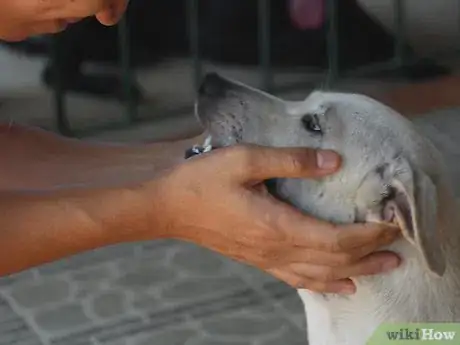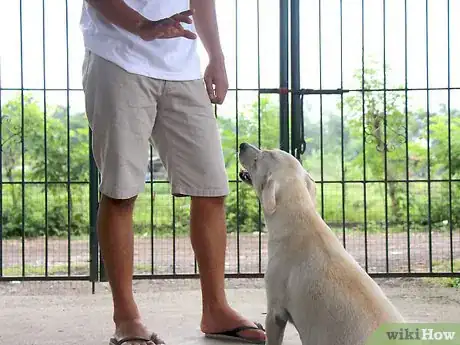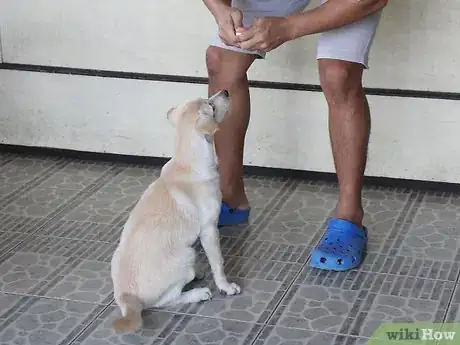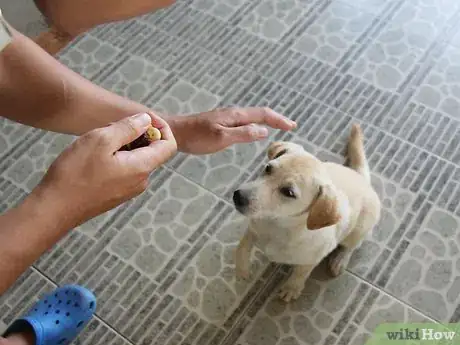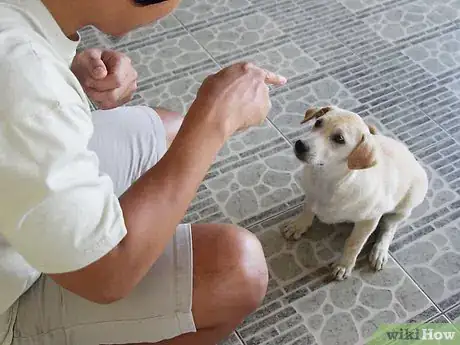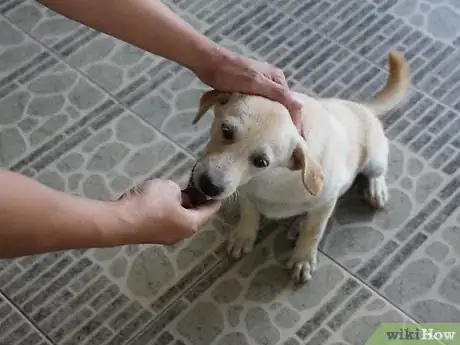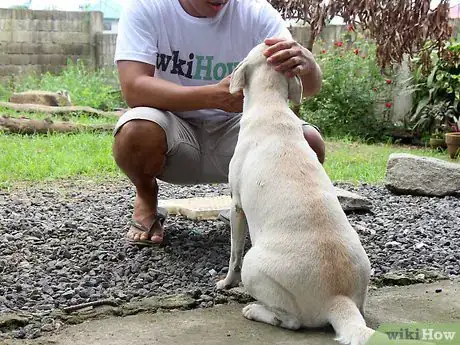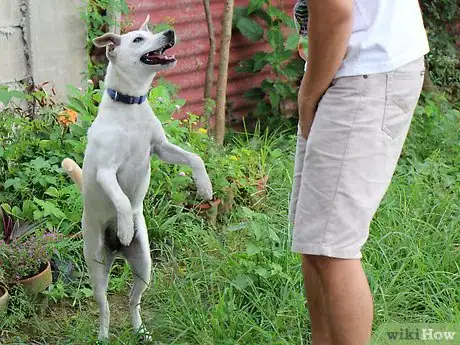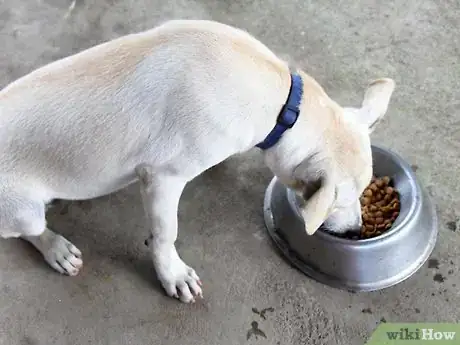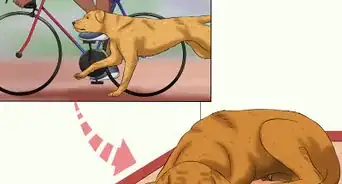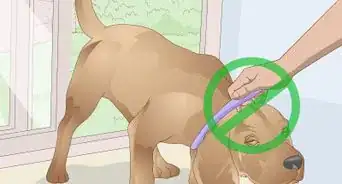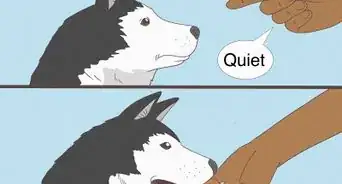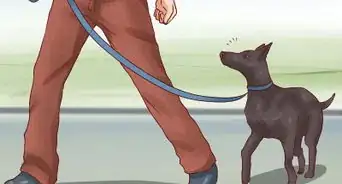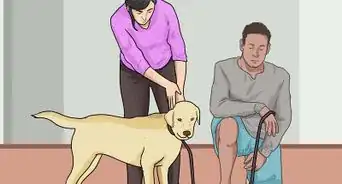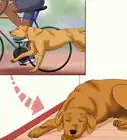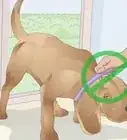This article was co-authored by Sophie Amphlett. Sophie Amphlett is a Professional Dog Trainer and Service Dog Coach with over five years of experience. Sophie graduated from CATCH Canine Trainers Academy’s Master Course with Distinction in 2016. She is also a Certified Trick Dog Instructor (CTDI) and a Certified Fun Scent Games Instructor (DN-FSG1). Sophie serves as a volunteer adoption counselor and dog walker for Adopt-A-Pet as well.
This article has been viewed 36,831 times.
Sitting is an important basic task when it comes to dog discipline. Without knowing how to sit, your dog will have a hard time learning how to stay, how to beg, and much more. Luckily, if you're having a hard time getting a disobedient dog to master this trick, all you need to do is follow one of a few different methods that are useful for getting a dog to sit down. Repeat this practice consistently until your dog learns the skill.
Steps
The "Watch and Wait" Method
-
1Wait until the dog sits down on his own. When you have some free time, grab a small treat and follow your dog around for a few minutes. Don't try to attract his attention or play with him. You just want to watch him while he does whatever he would be doing anyway.[1]
-
2Reward him as soon as he sits. Keep a careful eye on your dog without disturbing him. As soon as you notice him get into the "sit" position on his own, praise him and give him a small chunk of the treat. Tell him "sit" or "sit down" in a commanding voice (but not a harsh one). After this, leave the dog alone, but continue to watch him.
- You want to come across as affectionate here, not startling. Speak loudly enough to get your dog's attention, but not loudly enough to shock him out of his sitting position.
Advertisement -
3Keep practicing. Continue to watch your dog. As soon as he sits again, offer him another piece of the treat, praise him, and give the "sit" command. Repeat this process each time your dog sits on his own.[2]
- Use short practice sessions — 5-10 minutes should be long enough. Don't continue for longer, otherwise he will associate "Sit" (and treats) with boredom. Repeat this every day for a week.
-
4Eventually, try using the "sit" command on its own. Over time, the dog will start to associate the sitting position with receiving praise and treats. After about a week of practice, try getting your dog's attention and giving the "sit" command. If he responds correctly, praise him and give him a piece of a treat. Now, you can start practicing the command itself.
- If your dog hasn't learned the command yet, keep practicing. Some dogs take longer than others to learn new tricks.
The "Encouragement" Method
-
1Get your dog to focus on a treat in your hand. Using treats, you can lure the dog into the "sit" position easily. Start by holding a treat in your hand. Move it in front of the dog's nose for her to smell, but don't let her have it. You should get your dog's attention quickly.[3]
-
2Hold the treat above your dog's head. Once you have her attention, slowly bring the treat up over her head. Her nose should follow the treat. As you move higher and higher, the dog will have a harder time following the treat.[4]
- Be careful not to hover over the dog's head too high, or she may jump up to grab it. If she does, carefully try again; if she keeps jumping up for it, don’t continue. If you do, she might think jumping for the treat is good behavior. Once you can do this without her jumping up, continue again. Eventually, she'll need to sit down to keep her nose on the treat.
#*You can use a hand signal where you keep your palm out and forearms at a right angle. Lift your hand with the food lure in your hand above her.[5]
-
1
- As you lift it, she will follow it with her nose. Her nose will be at a 90-degree angle and point up. It will make her butt go down, and the second the butt touches the ground, you can click the clicker.[6]
- The clicker is a very effective tool in teaching a dog. Give her a treat every time you click.[7]
-
2Give the "sit" command. Before your dog sits, ask her to "sit" in a clear, commanding tone. Do this every time you practice the command, so that your dog will associate the verbal cue with the act of sitting.
-
3Reward the dog as soon as she sits. Your dog should eventually sit down as the treat goes over her head. At this point, you should give her the treat and praise her with affection.
- To continue practicing, let your dog lose interest, then repeat the process again. Practice for 5-10 minutes at a time for at least a week or so.
More Training Ideas
-
1For best results, practice in a wide variety of situations. Dogs are easily distracted by new places and situations. If your dog learns how to do the "sit" command perfectly alone in your kitchen, you may not be able to count on her to do it when she's at the park with her canine companions. Teach your dog to sit in many different environments to ensure that you can always count on her to obey you when it counts.[8]
- You may want to make the command part of your daily routine. For example, you can try doing it when you put her leash on, before going through doorways together, before she is fed, before you throw a ball, when she's around other dogs, or whenever else you think it's suitable.
-
2Be open to rewards besides treats. You don't have to feed your dog treats to reward her for good behavior. Almost anything that your dog likes can be used as an incentive, so don't be afraid to get creative! The main goal is to have your dog associate sitting with positive feelings — this doesn't necessarily have to mean food. A few more ideas you may want to consider include:
- Play time
- A favorite toy
- Love, affection, and petting
- Encouraging, praising words
-
3Make sitting a prerequisite for things the dog likes. Once your dog is good at sitting, you can make your life as a dog owner easier by teaching him to sit to get what he wants. Make it a habit to command your dog to sit for his food, to get his leash put on, to get let out to go to the bathroom, and so on. As long as you are consistent, your dog should eventually learn that the best way to get these things is to sit and be quiet — not to bark, beg, and bother you!
-
4Give your dog a gentle push in the right direction if he needs it. Most dogs shouldn't be too hard to train with either of the methods above. If your dog just doesn't seem to understand what you want when you're training him to sit, try pushing gently downward on the dog's lower back as you command him to sit. As soon as he gets into the correct position, praise and reward him as you normally would.
- Be gentle here. It's never a good idea to use violence or intimidation when teaching a dog commands. Not only does this run the risk of confusing the dog, but also risks inflicting lasting psychological damage.
Expert Q&A
-
QuestionHow do you get a stubborn dog to come when called?
 Emily Fleisher, CTBCEmily Fleisher is a Certified Dog Trainer and Behavior Consultant (CTBC) and the Founder of Mindful Paw, a dog training business based in San Francisco, California. She is certified in canine CPR, first aid, and dog training from the Dog Training Internship Academy. She also has a Certificate of Excellence through Dr. Susan Friedman's "Living and Learning with Animals" program. She completed an internship at the San Francisco SPCA (a Society for the Prevention of Cruelty to Animals) and continues her education through the Fenzi Dog Sports Academy and Jean Donaldson's Academy for Dog Trainers. She has a BA in Public Health from the University of Florida.
Emily Fleisher, CTBCEmily Fleisher is a Certified Dog Trainer and Behavior Consultant (CTBC) and the Founder of Mindful Paw, a dog training business based in San Francisco, California. She is certified in canine CPR, first aid, and dog training from the Dog Training Internship Academy. She also has a Certificate of Excellence through Dr. Susan Friedman's "Living and Learning with Animals" program. She completed an internship at the San Francisco SPCA (a Society for the Prevention of Cruelty to Animals) and continues her education through the Fenzi Dog Sports Academy and Jean Donaldson's Academy for Dog Trainers. She has a BA in Public Health from the University of Florida.
Professional Dog Trainer & Behavior Consultant Be very clear with your commands and hand gestures so your dog has a better chance of success.
Be very clear with your commands and hand gestures so your dog has a better chance of success.
References
- ↑ https://www.akc.org/expert-advice/training/teach-your-puppy-these-5-basic-commands/#sit
- ↑ https://www.akc.org/expert-advice/training/teach-your-puppy-these-5-basic-commands/#sit
- ↑ https://figopetinsurance.com/blog/5-basic-puppy-commands
- ↑ https://figopetinsurance.com/blog/5-basic-puppy-commands
- ↑ https://www.akc.org/expert-advice/training/how-to-teach-your-dog-to-sit/
- ↑ https://www.akc.org/expert-advice/training/how-to-teach-your-dog-to-sit/
- ↑ https://www.akc.org/expert-advice/training/how-to-teach-your-dog-to-sit/
- ↑ https://www.petexpertise.com/dog-training-article-sit-down-and-stay-articles/
About This Article
To teach a stubborn dog to sit down, start by holding a treat out for it to smell. Next, raise the treat above your dog’s head, which will force it to sit. Then, command your dog to “Sit” and reward the dog as soon as it does by giving it the treat. Alternatively, watch your dog until it sits down by itself. Then, give the “Sit” command, praise it, and give it a treat. Repeat this during 10-minute training sessions for about a week. Afterwards, try commanding your dog to sit without giving it a treat, since it should understand the command by this point. For tips on how to reward your dog without giving it treats, read on!


